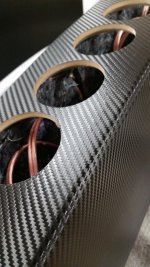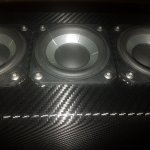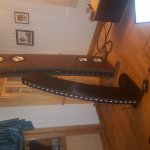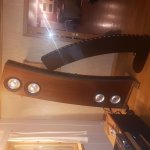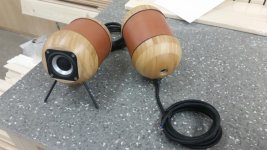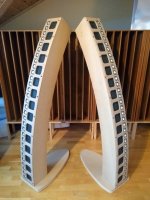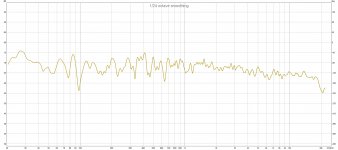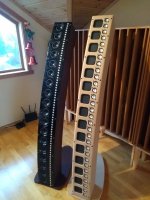On timadsen's comments about the center-to-center spacing and possible combing between drivers let me say that my Modified CBT24 doesn't exhibit these effects. I have repeated Don Keele's suggestions of listening at 2 inches, 2 feet, and 20 feet distance from the array and I hear essentially no combing or variation in sound as I move toward or away from the sound source. Nor do I hear significant variation across the sound stage with my speakers as I move side-to-side. Patrick Bateman has thoughts on why CBTs exhibit these observations in his above comments.
On using larger drivers in a CBT: You can do that but there are trades that you make with any driver choice. First, the volume of the enclosure and its height is directly impacted by any change. For example, the 2.5" SB65 drivers lead to approximately a 60" speaker height for a 36 degrees arc angle for a CBT24 style array. As you iterate the driver diameter a half inch (say to 3", 3.5" or 4") you increase the height a foot per each change so you are looking at a 6', 7' or 8' heights as you iterate. Likewise, the volume of the enclosure jumps as you use larger drivers. My choice of the SB65 unit leads to an attractive curved array with reasonable size, excellent specs, and better control of beaming than larger drivers.
With his CBT arrays Keele claims 3D sound radiation with constant beamwidth, constant directivity, constant coverage, and constant radiated power. What is not to like?
On using larger drivers in a CBT: You can do that but there are trades that you make with any driver choice. First, the volume of the enclosure and its height is directly impacted by any change. For example, the 2.5" SB65 drivers lead to approximately a 60" speaker height for a 36 degrees arc angle for a CBT24 style array. As you iterate the driver diameter a half inch (say to 3", 3.5" or 4") you increase the height a foot per each change so you are looking at a 6', 7' or 8' heights as you iterate. Likewise, the volume of the enclosure jumps as you use larger drivers. My choice of the SB65 unit leads to an attractive curved array with reasonable size, excellent specs, and better control of beaming than larger drivers.
With his CBT arrays Keele claims 3D sound radiation with constant beamwidth, constant directivity, constant coverage, and constant radiated power. What is not to like?
Last edited:
Hi Jim:
What is not to like? the cost of the drivers?
You mention "no variation side to side" and then later you say the SB65 offers better control of beaming than larger drivers (like the cheaper TC9). But I see beaming starts fairly early on the SB65's data sheet also and so I wonder how this beaming at HF effect affects the width of the sweet spot. Can you make comparison to earlier CBTs that used side by side woofers and tweeters?
What is not to like? the cost of the drivers?
You mention "no variation side to side" and then later you say the SB65 offers better control of beaming than larger drivers (like the cheaper TC9). But I see beaming starts fairly early on the SB65's data sheet also and so I wonder how this beaming at HF effect affects the width of the sweet spot. Can you make comparison to earlier CBTs that used side by side woofers and tweeters?
Relaxing the theory
Thanks to Patrick and Jim for quick and good response.
Patrick, about (b). I do see your point about the shadding, but the lower/first part of the array is without shadding and it is the biggest part (40%), so some form of comb-line/filtering should be present.
Jim, you are 100% right. What not to like about the SB65............well as nc555 is saying, the price. I live on the other side of the pond and with tax (25%), transport, import tax ext. they will end up costing around 50U$ EACH. A little over the top I think for just dipping your toes into the CBT-world.
This is why I am looking for a smaller scale start-up and why I am asking about the c-t-c distance vs. comb-filter.
Right now I am looking at 12 pcs. of 3" or 4" pr. side. If one could move up to 4" it would (almost) be possible to EQ it to some OK low-freq response.
Again a great thread.
BR
Thomas
Thanks to Patrick and Jim for quick and good response.
Patrick, about (b). I do see your point about the shadding, but the lower/first part of the array is without shadding and it is the biggest part (40%), so some form of comb-line/filtering should be present.
Jim, you are 100% right. What not to like about the SB65............well as nc555 is saying, the price. I live on the other side of the pond and with tax (25%), transport, import tax ext. they will end up costing around 50U$ EACH. A little over the top I think for just dipping your toes into the CBT-world.
This is why I am looking for a smaller scale start-up and why I am asking about the c-t-c distance vs. comb-filter.
Right now I am looking at 12 pcs. of 3" or 4" pr. side. If one could move up to 4" it would (almost) be possible to EQ it to some OK low-freq response.
Again a great thread.
BR
Thomas
Right now I am looking at 12 pcs. of 3" or 4" pr. side. If one could move up to 4" it would (almost) be possible to EQ it to some OK low-freq response.
Ideally the drivers in a CBT would be somewhere around an inch in diameter, maybe even less. CTC spacing determines how high the array will play, so the smaller the better.
24 of the SB65 full-range drivers have a surface area of 480, or about the same as a 12" woofer.
Getting an array to play LOW is never the problem, it's getting them to play HIGH...
I think if you chose a 1.5" or smaller driver, you would have difficulty getting it to play low enough without a companion woofer array, not to say you couldn't brute force the solution.
Its a really tough tradeoff. A nice slender array of 2" or 2.5" drivers assisted by subs in the background vs a fat baffle containing a column of tweeters and one or two columns of woofers. Now if I can find a way to hide the woofers in back of the tweeters (like JBL does) that I can construct myself then maybe I could get off the fence.
And I can attest the SB65 is indeed the cream of the crop of that size driver having just measured one myself
Its a really tough tradeoff. A nice slender array of 2" or 2.5" drivers assisted by subs in the background vs a fat baffle containing a column of tweeters and one or two columns of woofers. Now if I can find a way to hide the woofers in back of the tweeters (like JBL does) that I can construct myself then maybe I could get off the fence.
And I can attest the SB65 is indeed the cream of the crop of that size driver having just measured one myself
If you study commercial line array designs, you can consider the AudioMachina XTAC floor to ceiling line array project. The XTAC individual modules have 6 drivers and are listed as 15.625" long. Hence, their c-t-c spacing is 2.604".
The XTAC drivers appear to be slightly smaller that the 2.5" SB65 units so they are likely in the 2 to 2.5" diameter class units.
Compare those dimensions to the c-t-c spacing for the Modified CBT24 which is 2.625".
AudioMachina >> XTAC
The XTAC drivers appear to be slightly smaller that the 2.5" SB65 units so they are likely in the 2 to 2.5" diameter class units.
Compare those dimensions to the c-t-c spacing for the Modified CBT24 which is 2.625".
AudioMachina >> XTAC
Last edited:
Those are beautiful! Is that a carbon fiber wrap?
You will like the sound as well.
Jim
Thanks on the behalf of the builder/owner (Overn) !
Yes, we did like the sound which is all over the room. We "borrowed" subs (16 X 10") from the "Bendits" (concave 3-way line sources).
These wonderful small dynamite drivers may be useful for any array. Wrappings are carbon fibre wrap from car pimpers workshop.
Pictures of your creations (and the IKEA-coconuts from last year):
Attachments
Last edited:
Wilbur-x wrote:
"Yes, we did like the sound which is all over the room. We "borrowed" subs (16 X 10") from the "Bendits" (concave 3-way line sources). "
Again this confirms Don Keele's comments about the coverage of a CBT. Constant beamwidth, constant directivity, constant coverage, constant radiated power/"
I'm hearing the same sound in my listening room with my CBTs. Your CBT creates a 'sweet room' effect versus just a 'sweet spot'. That is direct contrast to your concave 3-way line source project you pictured which yields a focused sound.
"Yes, we did like the sound which is all over the room. We "borrowed" subs (16 X 10") from the "Bendits" (concave 3-way line sources). "
Again this confirms Don Keele's comments about the coverage of a CBT. Constant beamwidth, constant directivity, constant coverage, constant radiated power/"
I'm hearing the same sound in my listening room with my CBTs. Your CBT creates a 'sweet room' effect versus just a 'sweet spot'. That is direct contrast to your concave 3-way line source project you pictured which yields a focused sound.
I have compared them neck to neck. The CBT36 kit was a great offer (the kit being sold now has a poorer cabinet construction than the former unfortunately), and the small tweeters pushes lobing so high in frequency that's never an issue even near field. However, I personally find this prototype CBT some steps above the CBT36.
Attachments
I have read through this entire thread since I am interested in building a Griffin CBT24 in order to achieve a low-distortion presentation of classical music.I'm sure that a large choir singing Bach would be an impressive event with a large and realistic soundstage through this CBT.
What I am unsure of is how a solo instrument would sound. Take a solo harpsichord (2.3m long): Would this appear to be as wide and as high as the room (6m wide x 2.7m high)? If so that would be unrealistic.
If anyone is interested I could supply a high-quality harpsichord recording to try out on a CBT24 (or similar). With a well-balanced open baffle speaker system the harpsichord sounds to be about 2m behind the speakers and has a well-defined position and is about lifesize. What is the line array experience on this matter?
What I am unsure of is how a solo instrument would sound. Take a solo harpsichord (2.3m long): Would this appear to be as wide and as high as the room (6m wide x 2.7m high)? If so that would be unrealistic.
If anyone is interested I could supply a high-quality harpsichord recording to try out on a CBT24 (or similar). With a well-balanced open baffle speaker system the harpsichord sounds to be about 2m behind the speakers and has a well-defined position and is about lifesize. What is the line array experience on this matter?
ENCR,
Let me address your question about the sound of my CBT24 speakers. As you realize the sound emitted by loudspeakers can often be less impressive that listening to a live performance. When you listen to a live performance you hear the performance and the ambiance of the performers within the space wherein the sound was created. Some loudspeakers they may not produce a realistic reproduction of the music as performed live.
From my CBT24 speakers I hear a more realistic reproduction of the original sound in scale (a solo performer sounds appropriately sized while an orchestra sounds just as you expect). No enlarged wall of sound results for every recording but a more natural presentation for each track.
I don't have any harpsichord recordings but I do listen to recordings that have music that features solo piano. From my CBT24s the piano reproduction is realistic and satisfying to my ears. You clearly have more acute hearing than my casual listening as you can clearly specify location and more exact size of the music, but I think you would be pleased with the CBT24s.
If you can give me a link to available on-line harpsichord recordings or if you supply a recording, I can listen and report back to you.
Jim
Let me address your question about the sound of my CBT24 speakers. As you realize the sound emitted by loudspeakers can often be less impressive that listening to a live performance. When you listen to a live performance you hear the performance and the ambiance of the performers within the space wherein the sound was created. Some loudspeakers they may not produce a realistic reproduction of the music as performed live.
From my CBT24 speakers I hear a more realistic reproduction of the original sound in scale (a solo performer sounds appropriately sized while an orchestra sounds just as you expect). No enlarged wall of sound results for every recording but a more natural presentation for each track.
I don't have any harpsichord recordings but I do listen to recordings that have music that features solo piano. From my CBT24s the piano reproduction is realistic and satisfying to my ears. You clearly have more acute hearing than my casual listening as you can clearly specify location and more exact size of the music, but I think you would be pleased with the CBT24s.
If you can give me a link to available on-line harpsichord recordings or if you supply a recording, I can listen and report back to you.
Jim
Last edited:
Jim,
This is encouraging news. I have sent you a link to the harpsichord music via a PM since it is copyrighted material.
I have never heard a line array nor even an electrostatic speaker, although I have some Stax electrostatic headphones, but Alan Shaw of Harbeth once wrote in their user group how a Quad ELS57 would give such a large image of a singer, which he found so unconvincing that he stayed with conventional electromotive devices.
Of course, under some circumstancse the loudspeakers should deliver a large soundstage. When I heard a live performance of Wagner's "Die Walküre" earlier this year I closed my eyes to assess the size of the soundstage: it was not a small central image but spread across the whole theatre.
This is encouraging news. I have sent you a link to the harpsichord music via a PM since it is copyrighted material.
I have never heard a line array nor even an electrostatic speaker, although I have some Stax electrostatic headphones, but Alan Shaw of Harbeth once wrote in their user group how a Quad ELS57 would give such a large image of a singer, which he found so unconvincing that he stayed with conventional electromotive devices.
Of course, under some circumstancse the loudspeakers should deliver a large soundstage. When I heard a live performance of Wagner's "Die Walküre" earlier this year I closed my eyes to assess the size of the soundstage: it was not a small central image but spread across the whole theatre.
[/QUOTE] Regarding the Visaton FR7:
This driver has several shortcomings vs. the SB Acoustics SB65 driver. You noted that the Fs is high which would raise the crossover from sub woofers or woofers. The frequency response is rough--sags in upper mid-range and lower treble regions--while the treble rolls off over the upper octave. These frequency issues necessitate EQ'ing. Also the Visaton driver has lower Xmax than the SB65.
The Visaton driver could be used if you intend to create a lower cost array with less performance than the SB65 array.[/QUOTE]
Greetings from the snowy/cold Upper Peninsula of Michigan!
I would like to construct a line array using the Visaton FRS7-4. The reason for this particular speaker is I was able to buy 50 of them for $0.38 ... thirty-eight cents each! I couldn’t refuse.
So... I have been trying to determine the best enclosure:
Sealed
Vented
Open baffle
I’ve plugged in the values and depending on which “enclosure calculator” I have used, some suggest vented (BR) others using same data results in sealed. Would you please help in determining best for the line array. 20 to 24 per enclosure.
Thank you, have a good and Godly day
Bruce
This driver has several shortcomings vs. the SB Acoustics SB65 driver. You noted that the Fs is high which would raise the crossover from sub woofers or woofers. The frequency response is rough--sags in upper mid-range and lower treble regions--while the treble rolls off over the upper octave. These frequency issues necessitate EQ'ing. Also the Visaton driver has lower Xmax than the SB65.
The Visaton driver could be used if you intend to create a lower cost array with less performance than the SB65 array.[/QUOTE]
Greetings from the snowy/cold Upper Peninsula of Michigan!
I would like to construct a line array using the Visaton FRS7-4. The reason for this particular speaker is I was able to buy 50 of them for $0.38 ... thirty-eight cents each! I couldn’t refuse.
So... I have been trying to determine the best enclosure:
Sealed
Vented
Open baffle
I’ve plugged in the values and depending on which “enclosure calculator” I have used, some suggest vented (BR) others using same data results in sealed. Would you please help in determining best for the line array. 20 to 24 per enclosure.
Thank you, have a good and Godly day
Bruce
I think the person you quoted was unnecessarily pessimistic about the FRS7. Not as nice as the SB65 for sure but a huge value at 38 cents. You can certainly make a line array with them provided you work around the lmited Xmax with woofer/subwoofer support at 200 Hz and below. To me that means a sealed enclosure for easy XO to the woofer(s). In the best of all possible worlds you would find an equally good deal on a number of 6.5" or 8" woofers for a line of woofers next to the FRS7s but do the best you can with what you have and budget permits and plan on doing some equalization.
- Home
- Loudspeakers
- Full Range
- My New Line Array--It's a Modified CBT24
